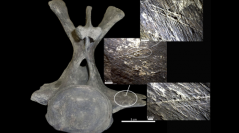

 Comptes Rendus Palevol
16 (4) - Pages 440-451
Comptes Rendus Palevol
16 (4) - Pages 440-451This paper describes human-modified bones originally from the Pampas region, and that form part of nineteenth-century fossil collections of native fauna. We describe the morphological and configurational features of the marks, relate them to the various stages in the butchering process, and discuss access type. An examination of various different American sites is used to interpret this evidence at a coarse-grained level. Although these collections are more biased than current archaeological materials with regard to their sedimentary origin and previous handling, the application of modern technology has allowed us to obtain new data. Therefore, despite their complex history, these artefacts can be incorporated into the broader body of modern archaeological research. This type of study adds new value to our historic heritage and underscores its usefulness in modern enquiries, in this case, related to the topic of how Homo sapiens interacted with the native fauna in the southern Cone of South America.
Megafauna, Human dispersal, Butchering process, Cut marks, Museum collections